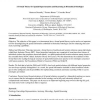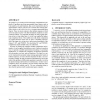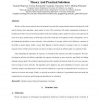1863 search results - page 79 / 373 » Unifying Theories of Objects |
ARTMED
2006
13 years 9 months ago
2006
Objective: The objective of this paper is to demonstrate how a formal spatial theory can be used as an important tool for disambiguating the spatial information embodied in biomed...
EJC
2003
13 years 10 months ago
2003
The goal of this paper is to build a bridge from a certain intuitive conception of natural language communication, called the SLIM theory of language, to a technical approach, cal...
STOC
2010
ACM
14 years 1 months ago
2010
ACM
We propose a new framework for discussing computational complexity of problems involving uncountably many objects, such as real numbers, sets and functions, that can be represente...
WINET
2002
13 years 8 months ago
2002
Wireless ad-hoc sensor networks have the potential to provide the missing interface between the physical world and the Internet, thus impacting a large number of users. This conne...
SOFSEM
2009
Springer
14 years 1 months ago
2009
Springer
In this text we will discuss different forms of randomness in Natural Sciences and present some recent results relating them. In finite processes, randomness differs in various ...



